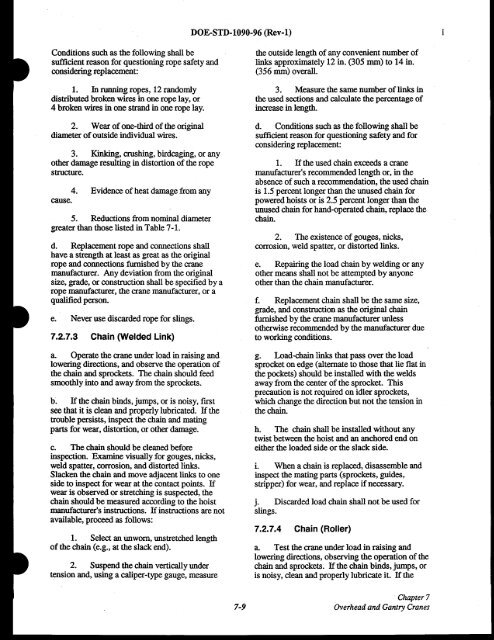DOE-STD-1090-96, DOE Standard Hoisting and Rigging Manual ...
DOE-STD-1090-96, DOE Standard Hoisting and Rigging Manual ...
DOE-STD-1090-96, DOE Standard Hoisting and Rigging Manual ...
Create successful ePaper yourself
Turn your PDF publications into a flip-book with our unique Google optimized e-Paper software.
<strong>DOE</strong>-<strong>STD</strong>-I090-<strong>96</strong> (Rev-I)Conditions such as the following shall besufficient reason for questioning rope safety <strong>and</strong>considering replacement:1. In running ropes, 12 r<strong>and</strong>omlydistributed broken wires in one rope lay, or4 broken wires in one str<strong>and</strong> in one rope lay.2. Wear ofone-third ofthe originaldiameter ofoutside individual wires.3. Kinking, crushing, birdcaging, or anyother damage resulting in distortion ofthe ropestructure.4. Evidence ofheat damage from anycause.5. Reductions from nominal diametergreater than those listed in Table 7-1.d. Replacement rope <strong>and</strong> connections shallhave a strength at least as great as the originalrope <strong>and</strong> connections furnished by the cranemanufacturer. Any deviation from the originalsize, grade, or construction shall be specified by arope manufacturer, the crane manufacturer, or aqualified person.e. Never use discarded rope for slings.7.2.7.3 Chain (Welded Link)a. Operate the crane under load in raising <strong>and</strong>lowering directions, <strong>and</strong> observe the operation ofthe chain <strong>and</strong> sprockets. The chain should feedsmoothly into <strong>and</strong> away from the sprockets.b. Ifthe chain binds, jumps, or is noisy, firstsee that it is clean <strong>and</strong> properly lubricated. Ifthetrouble persists, inspect the chain <strong>and</strong> matingparts for wear, distortion, or other damage.c. The chain should be cleaned beforeinspection. Examine visually for gouges, nicks,weld spatter, corrosion, <strong>and</strong> distorted links.Slacken the chain <strong>and</strong> move adjacent links to oneside to inspect for wear at the contact points. Ifwear is observed or stretching is suspected, thechain should be measured according to the hoistmanufacturer's instructions. Ifinstructions are notavailable, proceed as follows:1. Select an Unworn, unstretched lengthofthe chain (e.g., at the slack end).2. Suspend the chain vertically undertension <strong>and</strong>, using a caliper-type gauge, measurethe outside length ofany convenient number oflinks approximately 12 in. (305 nun) to 14 in.(356 nun) overall.3. Measure the same number oflinks inthe used sections <strong>and</strong> calculate the percentage ofincrease in length.d. Conditions such as the following shall besufficient reason for questioning safety <strong>and</strong> forconsidering replacement:1. Ifthe used chain exceeds a cranemanufacturer's recommended length or, in theabsence ofsuch a recommendation, the used chainis 1.5 percent longer than the unused chain forpowered hoists or is 2.5 percent longer than theunused chain for h<strong>and</strong>-operated chain, replace thechain.2. The existence ofgouges, nicks,corrosion, weld spatter, or distorted links.e. Repairing the load chain by welding or anyother means shall not be attempted by anyoneother than the chain manufacturer.f. Replacement chain shall be the same size,grade, <strong>and</strong> construction as the original chainfurnished by the crane manufacturer unlessotherwise recommended by the manufacturer dueto working conditions.g. Load-chain links that pass over the loadsprocket on edge (alternate to those that lie flat inthe pockets) should be installed with the weldsaway from the center ofthe sprocket. Thisprecaution is not required on idler sprockets,which change the direction but not the tension inthe chain.h. The chain shall be installed without anytwist between the hoist <strong>and</strong> an anchored end oneither the loaded side or the slack side.i. When a chain is replaced, disassemble <strong>and</strong>inspect the mating parts (sprockets, guides,stripper) for wear, <strong>and</strong> replace ifnecessary.j. Discarded load chain shall not be used forslings.7.2.7.4 Chain (Roller)a. Test the crane under load in raising <strong>and</strong>lowering directions, observing the operation ofthechain <strong>and</strong> sprockets. Ifthe chain binds, jumps, oris noisy, clean <strong>and</strong> properly lubricate it. Ifthe7-9Chapter 7Overhead <strong>and</strong> Gantry Cranes
















